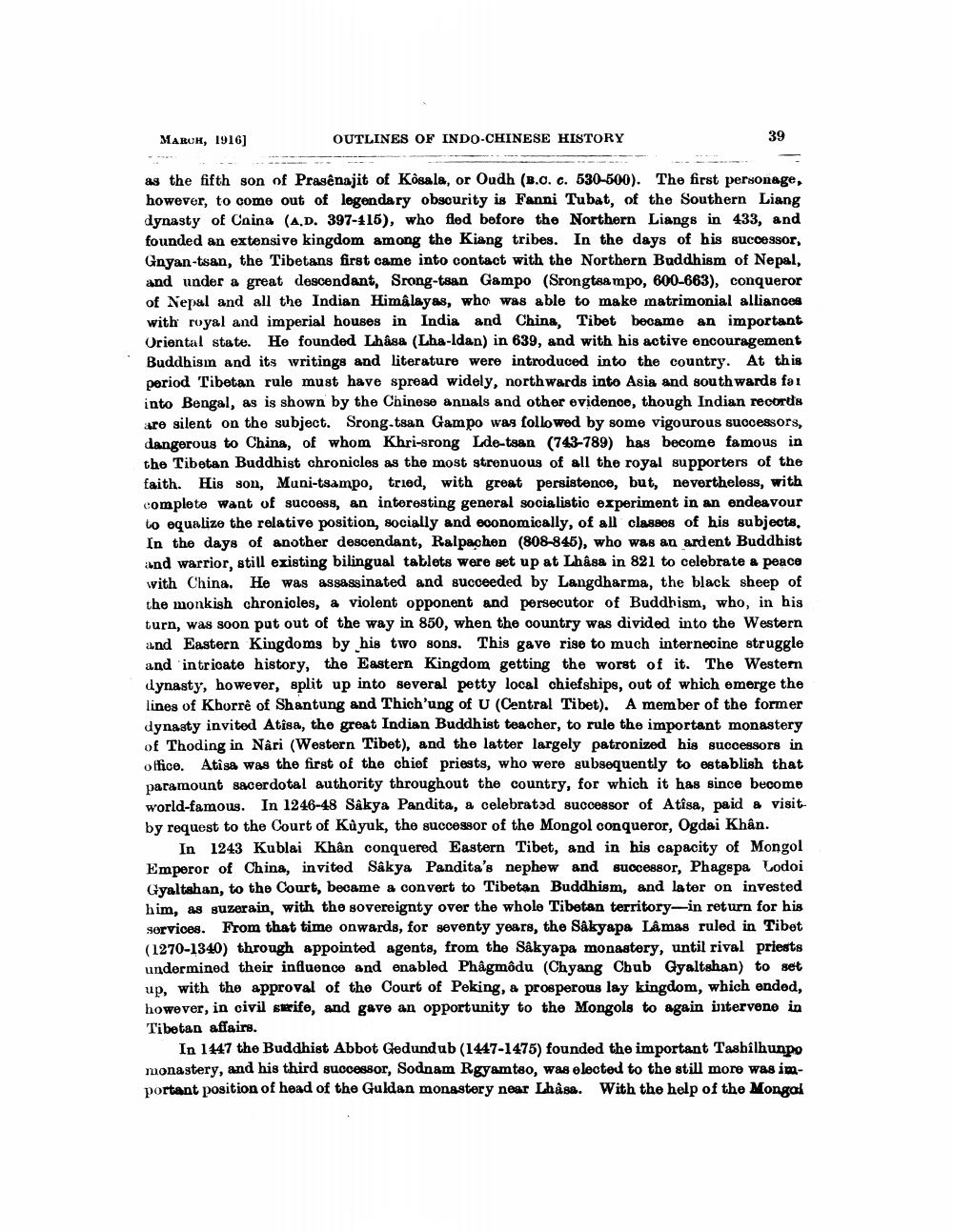________________
MARCH, 1916)
OUTLINES OF INDO-CHINESE HISTORY
39
as the fifth son of Prasenajit of Kösala, or Oudh (B.C. C. 530-500). The first personage, however, to come out of legendary obscurity is Fanni Tubat, of the Southern Liang dynasty of Caina (A.D. 397-415), who fled before the Northern Liangs in 433, and founded an extensive kingdom among the Kiang tribes. In the days of his successor, Gayan-tsan, the Tibetans first came into contact with the Northern Buddhism of Nepal, and under a great descendant, Srong-tsan Gampo (Srongtsa mpo, 600-663), conqueror of Nepal and all the Indian Himalayas, who was able to make matrimonial alliances with royal and imperial houses in India and China, Tibet became an important Oriental state. He founded Lhasa (Lha-ldan) in 639, and with his active encouragement Buddhism and its writings and literature were introduced into the country. At this period Tibetan rule must have spread widely, northwards into Asia and south wards for into Bengal, as is shown by the Chinese anuals and other evidence, though Indian recortis are silent on the subject. Srong.tsan Gampo was followed by some vigourous successors, dangerous to China, of whom Khri-srong Lde-tsan (743-789) has become famous in the Tibetan Buddhist chronicles as the most strenuous of all the royal supporters of the faith. His son, Muni-tsampo, tried, with great persistence, but, nevertheless, with complete want of success, an interesting general socialistio experiment in an endeavour to equalize the relative position, socially and economically, of all classes of his subjects. In the days of another descendant, Ralpachen (808-845), who was an ardent Buddhist and warrior, still existing bilingual tablets were set up at Lhasa in 821 to celebrate a peace with China. He was assassinated and succeeded by Langdharma, the black sheep of the monkish chronicles, a violent opponent and persecutor of Buddhism, who, in his turn, was soon put out of the way in 850, when the country was divided into the Western and Eastern Kingdoms by his two sons. This gave rise to much internecine struggle and intricate history, the Eastern Kingdom getting the worst of it. The Western dynasty, however, split up into several petty local chiefships, out of which emerge the lines of Khorrè of Shantung and Thich'ung of U (Central Tibet). A member of the former dynasty invited Atisa, the great Indian Buddhist teacher, to rule the important monastery of Thoding in Nâri (Western Tibet), and the latter largely patronized his successors in office. Atîsa was the first of the chief priests, who were subsequently to establish that paramount sacerdotal authority throughout the country, for which it has since become world-famous. In 1246-48 Sakya Pandita, a celebratad successor of Atisa, paid a visitby request to the Court of Kuyuk, the successor of the Mongol conqueror, Ogdai Khân.
In 1243 Kublai Khân conquered Eastern Tibet, and in his capacity of Mongol Emperor of China, invited Sakya Pandita's nephew and successor, Phagepa Lodoi Gyaltahan, to the Court, became a convert to Tibetan Buddhism, and later on invested him, as suzerain, with the sovereignty over the whole Tibetan territory-in return for his services. From that time onwards, for seventy years, the Sakyapa Lamas ruled in Tibet (1270-1340) through appointed agents, from the Sakyapa monastery, until rival priests undermined their influence and enabled Phågmôdu (Chyang Chub Gyaltshan) to set up, with the approval of the Court of Peking, a prosperous lay kingdom, which ended, however, in civil srife, and gave an opportunity to the Mongols to again intervene in Tibetan affairs.
In 1447 the Buddhist Abbot Gedundub (1447-1475) founded the important Tasbilhundo monastery, and his third successor, Sodnam Rgyamteo, was electou to the still more was important position of head of the Guldan monastery near Lhasa. With the help of the Mongal




